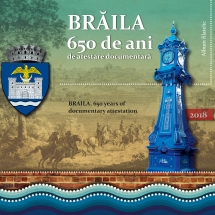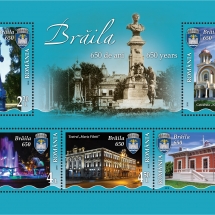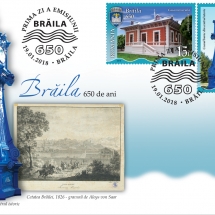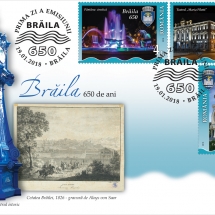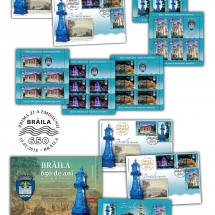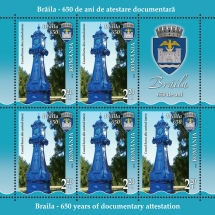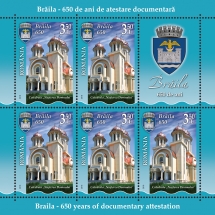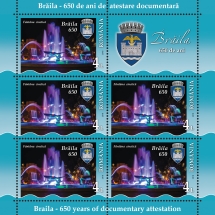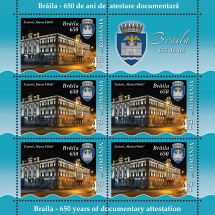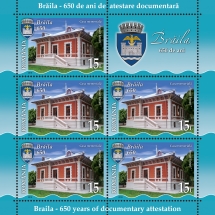 We are stepping in the year of the Centenary of the Great Union with the first philatelic issue dedicated to a romanian city. Brăila, the city with one of the earliest documentary attestation, is the country’s third oldest town after Câmpulung and Curtea de Argeş. The writer Panait Istrati said that following the Independence War of 1877, Brăila became the most important port-town of the Danube, and during that period, the city was “swimming” in gold and the inhabitants were prosperous.
We are stepping in the year of the Centenary of the Great Union with the first philatelic issue dedicated to a romanian city. Brăila, the city with one of the earliest documentary attestation, is the country’s third oldest town after Câmpulung and Curtea de Argeş. The writer Panait Istrati said that following the Independence War of 1877, Brăila became the most important port-town of the Danube, and during that period, the city was “swimming” in gold and the inhabitants were prosperous.
The inhabitants of Braila are very proud of their rich local history, having difficulties in establishing a hierarchy of the many places of interest that contribute to the identity of their city. The tourists can admire, for example, the Baroque Clock, the “Nativity of Our Lord” Cathedral, the Kinetic Fountain, the “Maria Filloti” Theatre, or the “Panail Istrati” Memorial House.
Romfilatelia invites you to discover the most important landmarks of the Danube City, introducing into circulation the postage stamp issue Braila, 650 years of documentary attestation. The new issue will be available on Friday, January 19th, 2018, in Romfilatelia’ own shops network in Bucharest, Bacau, Brașov, Cluj-Napoca, Iași and Timișoara and online on https://romfilatelia.ro/store/.
On the stamp with the face value of Lei 2.20 is depicted the Baroque Clock, which is situated in the old town. It is a remarkable monument, the work of Carol Sakar, and was erected in 1909. Made from cast and welded metal, this piece was used for park decoration. At the Public Clock’s base, an inscription on metal plates that reads “Carol Sakar; Praga-Karkin; Bohemia-Austria” was placed, together with a painted ship, the symbol of Danube, the river that borders the city.
The “Nativity of Our Lord” Cathedral illustrates the stamp with the face value of Lei 3.50. Its building began on April 16th, 1990, the second day of Eastertide. The plan of the cathedral has the Byzantine layout of a cross with uneven arms, and 2 choirs. The edifice is 42 meters long, and has a total height of 50 meters, as measured from the ground level to the ridge of the big spire’s helm, and is provided with five bells, electronically controlled. The impressive building dominates the Southern sides of the city. The cathedral features elements of traditional architecture, which has been nevertheless adjusted to respect current building regulations.
The Kinetic Fountain is displayed on the stamp with the face value of Lei 4. Located near the Administrative Palace, it is the work of Constantin Lucaci, a sculptor often compared to Brancusi, and renowned for his steel sculptures. The Monument brings forward two moving hands that unite in a hollow. The bright vibrations, the movements and the sonorousness join in an exquisite show, forming a unitary whole. The kinetic fountain is made from perfectly grinded inoxidable steel, and was cast at Factory Progresul Braila, being inaugurated in 1989.
Theatre “Maria Filotti” of Braila, a prestigious institution of the Romanian culture, which was built around 1850, is displayed on the stamp with the face value of Lei 4.50. A remarkable monument of architecture, the building was included on Romania’s National Heritage List. The construction contains several show halls, a conference room, foyers, etc. In 1969, the theatre was named after the renowned actress Maria Filloti. The theatre hosts the international festival “Days and Nights of European Theater”, as well as the International Canto Contest “Hariclea Darclee”.
The stamp with the face value of Lei 15 illustrates the “Panait Istrati” Memorial House, which belongs to the patrimony of the “Carol I” Museum of Braila. The house was built in neo-Romanian style at the beginning of the 20th century, and belonged to the city’s Public Garden. Panait Istrati never lived in this building. In 1984, a memorial exhibition to celebrate the centenary of the writer’s birth was organized in this house, many manuscripts and personal objects being subsequently acquired.
The postage stamp issue is completed by a set of two First Day Covers, as page composition there were used a sheet of 32 stamps, a minisheet of 5 stamps + 1 label, a block of 5 stamps (in the philatelic album), and the „First Day” postmark can be found at the Postal Office 1 Brăila, 8 Danubiului Street.
The philatelic album is created into a limited edition of 283 pieces and is equipped with the block of the issue (containing five perforated stamps with illustrated border), as well as the set of two First Day Covers with “first day” postmark cleary imprinted, with foiling, both products being numbered from 001 to 283.
Romfilatelia thanks Braila Municipality, the “Carol I” Museum, the Philatelic Association “Dunarea Braila” and the photographer George Avanu for the documentary and photographic support provided for this postage stamp issue.
For further information, please contact the Public Relation Office:
Tel: 021 / 337 24 42
roxana.herascu@romfilatelia.ro



